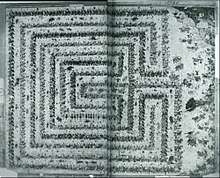Padmavyuha

The Padmavyūha (Sanskrit: पद्मव्यूह) or Chakravyūha (चक्रव्यूह) is a military formation depicted in the Hindu epic Mahabharata.
Background
The Padmavyūha is a multi-tiered defensive formation that looks like a blooming lotus (पद्म padma) or disc (चक्र chakra) when viewed from above.[1] The warriors at each interleaving position would be in an increasingly tough position to fight. The formation was used in the battle of Kurukshetra by Dronacharya, who became commander-in-chief of the Kaurava army after the fall of Bhishma Pitamaha.
The various vyūhas (military formations) were studied by the Kauravas and Pandavas alike. Most of them can be beaten using a counter-measure targeted specifically against that formation. It is important to observe that in the form of battle described in the Mahabharata, it was important to place powerful fighters in positions where they could inflict maximum damage to the opposing force, or defend their own side. As per this military strategy, a specific stationary object or a moving object or person could be captured, surrounded and fully secured during battle.
The formation begins with two soldiers on both sides, with other soldiers following them at a distance of three hands, drawing up seven circles and culminating in the end which is the place where the captured person or object is to be kept. In order to form the Chakravyuha, the commander has to identify soldiers who will form this formation. The number of soldiers to be deployed and the size of the Chakravyuha is calculated as per the resistance estimated. Once drawn, the foremost soldiers come on either side of the opponent to be captured, engage briefly and then advance. Their place is taken up by the next soldiers on either side, who again engage the opponent briefly and then advance. In this fashion, a number of soldiers pass the enemy and proceed in a circular pattern. By the time the rear of the formation arrives, the oblivious enemy is surrounded on all sides by seven tiers of soldiers. The last soldiers of the formation give the signal of completing the Chakravyuha. On the signal, every soldier who so far has been facing outwards turns inwards to face the opponent. It is only then that the captured enemy realizes his captivity. The army maintains the circular formation and can lead away the captive as well.
Abhimanyu and the Chakravyūha

The Chakravyūha or Padmavyūha was a very special formation (vyuha), and knowledge of how to penetrate it was limited to only a handful of warriors on the Pandavas' side, namely: Abhimanyu, Arjuna, Krishna and Pradyumna, of which only Abhimanyu was present when the Kauravas used it on the battlefield. In the Mahabharata it is mentioned that Abhimanyu learnt about the Chakravyūha while in his mother's womb but he was not able to hear how to escape the formation. After Abhimanyu had penetrated the sixth tier of the formation, all the Kauravas' commanders attacked him simultaneously, which was against the righteous rules of warfare Dharmayuddha, and gradually exhausted and killed him.[2]
See also
References
- ↑ Gopal, Madan (1990). K.S. Gautam, ed. India through the ages. Publication Division, Ministry of Information and Broadcasting, Government of India. p. 81.
- ↑ "The Mahabharata, Book 7: Drona Parva: Abhimanyu-badha Parva: Section XXXI". www.sacred-texts.com. Retrieved 2016-10-16.
